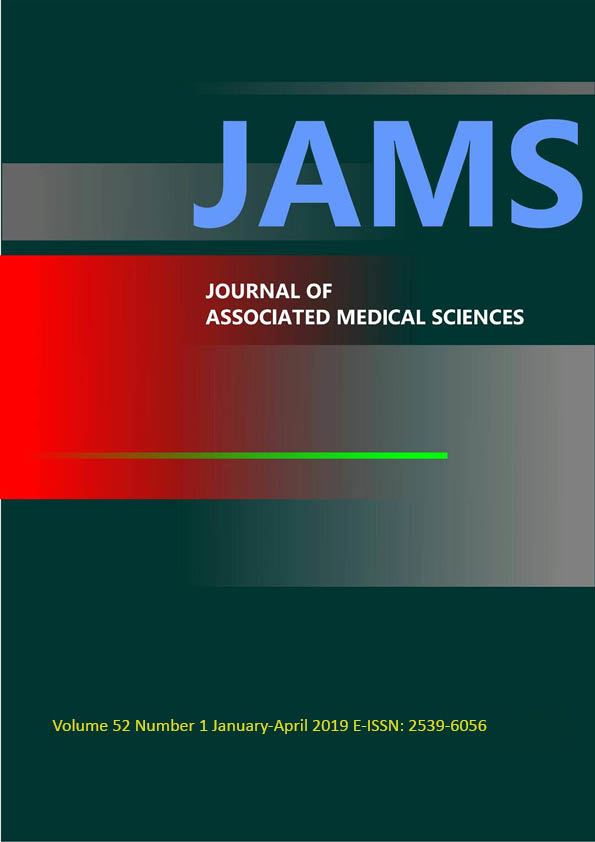Assessment of CareStartTM G6PD RDT for G6PD deficiency screening in newborns and malaria diagnosed subjects in the Northern Thailand
Main Article Content
Abstract
Background: Glucose-6-phosphate dehydrogenase (G6PD) deficiency is an inherited enzymatic disorder associated with severe neonatal hyperbilirubinemia and acute hemolysis after exposure to certain drugs or infections. The most common test for screening G6PD deficiency is fluorescent spot test which is rapid and convenient. However, fluorescent spot test needs tools and skills in diagnosis and interpretation of the results. CareStartTM G6PD Rapid Diagnosis Test (RDT) is an enzyme chromatographic strip test based on reduction of colorless nitro blue tetrazolium into formazan which gives purple color and the results could be read within 10 minutes.
Objectives: This study aimed to analyze the sensitivity, specificity and accuracy of CareStartTM G6PD RDT for screening of G6PD deficiency in newborn and subjects with malaria diagnosis.
Materials and methods: This study was conducted from December 2017 to February 2018. G6PD diagnostic tests including fluorescent spot test and CarestartTM G6PD RDT were performed in 196 newborns aged varied from 1 day to 12 years and 48 subjects with malaria diagnosis. The efficiency of CareStartTM G6PD RDT was analyzed by comparing with the reference method, fluorescent spot test.
Results: CareStartTM G6PD RDT demonstrated 100% sensitivity, 100% specificity and 100% accuracy for screening of G6PD deficiency in malarial diagnosed samples. However, it presented invalid results up to 27.04% in newborns. Therefore, sensitivity, specificity and accuracy were not applicable in this group.
Conclusion: CareStartTM G6PD RDT could be used for preliminary screening of G6PD deficiency in malarial diagnosed samples. However, it should be improved to reduce the invalid results in newborns.
Article Details

This work is licensed under a Creative Commons Attribution-NonCommercial-NoDerivatives 4.0 International License.
Personal views expressed by the contributors in their articles are not necessarily those of the Journal of Associated Medical Sciences, Faculty of Associated Medical Sciences, Chiang Mai University.
References
[2]. Nkhoma ET, Poole C, Vannappagari V, Hall SA, Beutler E. The global prevalence of glucose-6-phosphate dehydrogenase deficiency: a systematic review and meta-analysis. Blood Cells Mol Dis 2009; 42(3): 267-78.
[3]. Nuchprayoon I, Sanpavat S, Nuchprayoon S. Glucose-6-phosphate dehydrogenase (G6PD) mutations in Thailand: G6PD Viangchan (871G>A) is the most common deficiency variant in the Thai population. Hum Mutat 2002; 19(2): 185.
[4]. Cappellini MD, Fiorelli G. Glucose-6-phosphate dehydrogenase deficiency. Lancet 2008; 371(9606): 64-74.
[5]. Guindo A, Fairhurst RM, Doumbo OK, Wellems TE, Diallo DA. X-linked G6PD deficiency protects hemizygous males but not heterozygous females against severe malaria. PLoS Med 2007; 4(3): e66.
[6]. Mehta A, Mason PJ, Vulliamy TJ. Glucose-6-phosphate dehydrogenase deficiency. Baillieres Best Pract Res Clin Haematol 2000; 13(1): 21-38.
[7]. Watson J, Taylor WR, Menard D, Kheng S, White NJ. Modelling primaquine-induced haemolysis in G6PD deficiency. Elife. 2017; 6.
[8]. Ley B, Luter N, Espino FE, Devine A, Kalnoky M, Lubell Y, et al. The challenges of introducing routine G6PD testing into radical cure: a workshop report. Malar J 2015; 14: 377.
[9]. World Health Organization CDC. Severe falciparum malaria. Trans R Soc Trop Med Hyg 2000; 94(Suppl 1): S1-90.
[10]. Espino FE, Bibit JA, Sornillo JB, Tan A, von Seidlein L, Ley B. Comparison of Three Screening Test Kits for G6PD Enzyme Deficiency: Implications for Its Use in the Radical Cure of Vivax Malaria in Remote and Resource-Poor Areas in the Philippines. PLoS One 2016; 11(2): e0148172.
[11]. WHO. Guidelines for the treatment of malaria. Third ed. Geneva2015. 316 p.
[12]. MPAC. Point—of—care G6PD testing to support safe use of primaquine for the treatment of vivax malaria, WHO. Geneva, Switzerland:. 2015.
[13]. Kaplan M, Leiter C, Hammerman C, Rudensky B. Comparison of commercial screening tests for glucose-6-phosphate dehydrogenase deficiency in the neonatal period. Clin Chem 1997; 43(7): 1236-7.
[14]. Beutler E, Blume KG, Kaplan JC, Lohr GW, Ramot B, Valentine WN. International Committee for Standardization in Haematology: recommended screening test for glucose-6-phosphate dehydrogenase (G-6-PD) deficiency. Br J Haematol 1979; 43(3): 465-7.
[15]. Kim S, Nguon C, Guillard B, Duong S, Chy S, Sum S, et al. Performance of the CareStart G6PD deficiency screening test, a point-of-care diagnostic for primaquine therapy screening. PLoS One 2011; 6(12): e28357.
[16]. von Fricken ME, Weppelmann TA, Eaton WT, Masse R, Beau de Rochars MV, Okech BA. Performance of the CareStart glucose-6-phosphate dehydrogenase (G6PD) rapid diagnostic test in Gressier, Haiti. Am J Trop Med Hyg 2014; 91(1): 77-80.
[17]. Roh ME, Oyet C, Orikiriza P, Wade M, Mwanga-Amumpaire J, Boum Y, 2nd, et al. Screening for Glucose-6-Phosphate Dehydrogenase Deficiency Using Three Detection Methods: A Cross-Sectional Survey in Southwestern Uganda. Am J Trop Med Hyg 2016; 95(5): 1094-9.
[18]. Tripatara A. Diagnosis of G6PD deficiency. In: Fucharoen G, Sanchaisuriya E, editors. Laboratory tests for red blood cell abnormalities. 3rd ed. Division of Clinical Microscopy, Faculty of Medical Technology, Khon Kaen University, Khon Kaen; 2003: 105-13.
[19]. Adu-Gyasi D, Asante KP, Newton S, Dosoo D, Amoako S, Adjei G, et al. Evaluation of the diagnostic accuracy of CareStart G6PD deficiency Rapid Diagnostic Test (RDT) in a malaria endemic area in Ghana, Africa. PLoS One 2015; 10(4): e0125796.
[20]. Burka ER. Infectious disease: a cause of hemolytic anemia in glucose-6 phosphate dehydrogenase deficiency. Ann Intern Med.1969; 70(1): 222-5.
[21]. Satyagraha AW, Sadhewa A, Elvira R, Elyazar I, Feriandika D, Antonjaya U, et al. Assessment of Point-of-Care Diagnostics for G6PD Deficiency in Malaria Endemic Rural Eastern Indonesia. PLoS Negl Trop Dis 2016; 10(2): e0004457.


